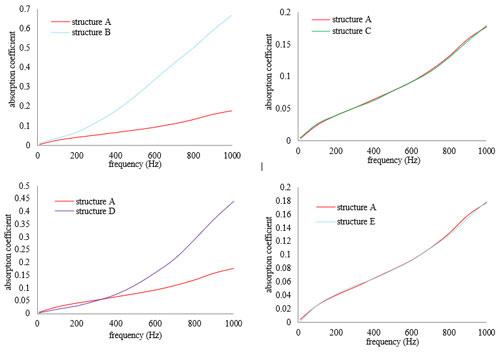Volume 11, Issue 3 (9-2021)
J Health Saf Work 2021, 11(3): 368-383 |
Back to browse issues page
Download citation:
BibTeX | RIS | EndNote | Medlars | ProCite | Reference Manager | RefWorks
Send citation to:



BibTeX | RIS | EndNote | Medlars | ProCite | Reference Manager | RefWorks
Send citation to:
Keyvani S, Monazzam Esmaielpour M, Fasih-Ramandi F, Ahmadi Asour A, Kolahdouzi M, Hashemi Z. Impact of Layout Sequence of the Natural and Synthetic Adsorbents in Double-Layered Composites on Improving the Natural Fiber Acoustic Performance Using the Numerical Finite Element Method. J Health Saf Work 2021; 11 (3) :368-383
URL: http://jhsw.tums.ac.ir/article-1-6533-en.html
URL: http://jhsw.tums.ac.ir/article-1-6533-en.html
Sepideh Keyvani1 
 , Mohammadreza Monazzam Esmaielpour1
, Mohammadreza Monazzam Esmaielpour1 
 , Fatemeh Fasih-Ramandi1
, Fatemeh Fasih-Ramandi1 
 , Akbar Ahmadi Asour2
, Akbar Ahmadi Asour2 
 , Malihe Kolahdouzi *
, Malihe Kolahdouzi * 
 3, Zahra Hashemi4
3, Zahra Hashemi4 


 , Mohammadreza Monazzam Esmaielpour1
, Mohammadreza Monazzam Esmaielpour1 
 , Fatemeh Fasih-Ramandi1
, Fatemeh Fasih-Ramandi1 
 , Akbar Ahmadi Asour2
, Akbar Ahmadi Asour2 
 , Malihe Kolahdouzi *
, Malihe Kolahdouzi * 
 3, Zahra Hashemi4
3, Zahra Hashemi4 

1- Department of Occupational Health Engineering, School of Health, Tehran University of Medical Sciences, Tehran, Iran
2- 1 Department of Occupational Health Engineering, School of Health, Tehran University of Medical Sciences, Tehran, Iran 2 Department of Occupational Health Engineering, School of Health, Sabzevar University of Medical Sciences, Razavi Khorasan, Iran
3- Department of Occupational Health Engineering, School of Health, Tehran University of Medical Sciences, Tehran, Iran ,mkolahdouzi89@gmail.com
4- Department of Occupational Health Engineering, School of Health, Behbahan University of Medical Sciences, Khuzestan, Iran
2- 1 Department of Occupational Health Engineering, School of Health, Tehran University of Medical Sciences, Tehran, Iran 2 Department of Occupational Health Engineering, School of Health, Sabzevar University of Medical Sciences, Razavi Khorasan, Iran
3- Department of Occupational Health Engineering, School of Health, Tehran University of Medical Sciences, Tehran, Iran ,
4- Department of Occupational Health Engineering, School of Health, Behbahan University of Medical Sciences, Khuzestan, Iran
Abstract: (1675 Views)
Introduction: The acoustic performance of natural fiber adsorbents has been investigated in numerous studies. A part of these materials show a poor adsorption within the frequency range of less than 1000 Hz. In the present study, attempts were made to investigate the effect of layout sequence of double-layered composites consisting of natural and synthetic fibers on improving the acoustic adsorption coefficient of natural fiber in the low-frequency range (63 to 1000 Hz) using the numerical finite element method.
Material and Methods: In this study, the finite element method and the Johnson-Champoux-Allard model in COMSOL software version 5.3a were used to investigate the acoustic performance of the double-layered composites consisting of natural and synthetic adsorbents. The acoustic absorbers under study included date palm fiber, polyurethane foam and cellular rubber. Each double-layered composite included a date palm fiber with 10mm in thickness and a synthetic adsorbent (polyurethane foam or cellular rubber) with 10mm in thickness. In sum, four double-layered composite structures with different layouts of adsorbents in each structure were studied.
Results: The location of natural fiber can play a critical role in the acoustic performance of the double-layered composite structures such that comparing the studied double-layered composites revealed that when the natural fiber was the first layer exposed to the normal sound in the double-layered composites with 20mm in thickness, the trend of acoustic performance was approximately the same as the single-layered composite of natural fiber with 20mm in thickness; but in the composite structures, when the synthetic adsorbent was the first layer exposed to the sound, the trend of acoustic absorption was improved.
Conclusion: On the basis of the results, the double-layered composite structure with a higher-density and lower-porosity upper layer showed a better acoustic absorption trend than the single-layered composite including the natural adsorbent.
Material and Methods: In this study, the finite element method and the Johnson-Champoux-Allard model in COMSOL software version 5.3a were used to investigate the acoustic performance of the double-layered composites consisting of natural and synthetic adsorbents. The acoustic absorbers under study included date palm fiber, polyurethane foam and cellular rubber. Each double-layered composite included a date palm fiber with 10mm in thickness and a synthetic adsorbent (polyurethane foam or cellular rubber) with 10mm in thickness. In sum, four double-layered composite structures with different layouts of adsorbents in each structure were studied.
Results: The location of natural fiber can play a critical role in the acoustic performance of the double-layered composite structures such that comparing the studied double-layered composites revealed that when the natural fiber was the first layer exposed to the normal sound in the double-layered composites with 20mm in thickness, the trend of acoustic performance was approximately the same as the single-layered composite of natural fiber with 20mm in thickness; but in the composite structures, when the synthetic adsorbent was the first layer exposed to the sound, the trend of acoustic absorption was improved.
Conclusion: On the basis of the results, the double-layered composite structure with a higher-density and lower-porosity upper layer showed a better acoustic absorption trend than the single-layered composite including the natural adsorbent.
Type of Study: Research |
Received: 2021/09/20 | Accepted: 2021/09/1 | Published: 2021/09/1
Received: 2021/09/20 | Accepted: 2021/09/1 | Published: 2021/09/1
Send email to the article author
| Rights and permissions | |
 |
This work is licensed under a Creative Commons Attribution-NonCommercial 4.0 International License. |




